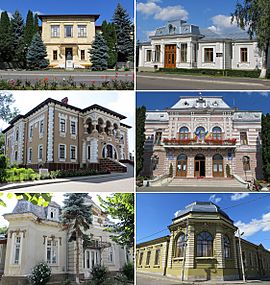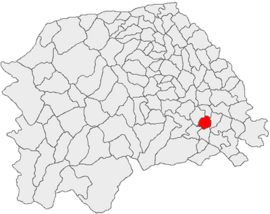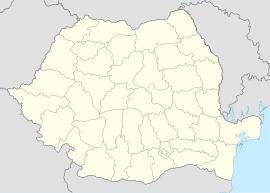Fălticeni facts for kids
Quick facts for kids
Fălticeni
|
||
|---|---|---|

From top-left, clockwise:
Nicu Gane National College, House of Notable People, City Hall, Mihai Băcescu Water Museum, Children's House, Ion Irimescu Art Museum |
||
|
||

Location in Suceava County
|
||
| Country | ||
| County | Suceava | |
| Area | 28.76 km2 (11.10 sq mi) | |
| Elevation | 348 m (1,142 ft) | |
| Population
(2011)
|
Lua error in Module:Wd at line 1,575: attempt to index field 'wikibase' (a nil value). | |
| Time zone | EET/EEST (UTC+2/+3) | |
| Postal code |
725200
|
|
| Area code | (+40) 02 30 | |
Fălticeni (pronounced fəltiˈt͡ʃenʲ) is a town in northeastern Romania. It is located in Suceava County and is part of the historical region called Western Moldavia.
Based on the 2021 census, Fălticeni is the third biggest town in its county. It became a municipality (a type of important town) in 1995. Two other towns in Suceava County, Rădăuți and Câmpulung Moldovenesc, also became municipalities at the same time.
Fălticeni covers about 28.76 square kilometers. A quarter of this area is made up of orchards and lakes. The town also includes two villages: Șoldănești and Țarna Mare. Fălticeni was once the capital of Baia County from 1929 to 1950. This town is famous for being the home or study place for many well-known Romanian writers, artists, and scientists.
Contents
Discovering Fălticeni's Location
Fălticeni is in the southern part of Suceava County. It is about 25 kilometers away from Suceava, which is the main city of the county.
The European route E85, an important road, goes right through Fălticeni. If you want to travel by train, Fălticeni is connected to Romania's railway system through the Dolhasca train station, which is 24 kilometers away. The city of Roman is 80 kilometers south of Fălticeni, also on the E85 road.
A Journey Through Fălticeni's Past
The first time the village of Folticeni was mentioned in writing was in March 1490. It was mentioned again in March 1554. At that time, Moldavian Prince Alexandru Lăpuşneanu gave the land and village to the Moldovița Monastery.
Fălticeni was first called a town in August 1780. It was known as Târgul Șoldănești (meaning Șoldănești Market). This name came from a local noble family's estate. In March 1826, Ioan Sturdza, another prince, officially changed the town's name to Fălticeni.
During World War I, Fălticeni was bombed by the Bolsheviks.
Before World War I, Fălticeni was the capital of Suceava County in the Romanian Old Kingdom. After Bukovina joined Romania and some administrative changes in 1925, Fălticeni became the capital of Baia County. It remained the capital until 1950. When counties were reorganized in 1968, Fălticeni became part of Suceava County again.
In 1921, the Faltishan (which is Yiddish for Fălticeni) Hasidic dynasty started in Fălticeni. It was founded by Rabbi Eluzar Twersky. He was from the important Skver Hasidic group and part of the respected royal Hasidic Twersky family. Today, there are Jewish communities in Brooklyn, New York, that still use the name Faltishan. They are led by Rabbi Twersky's family members.
Understanding Fălticeni's Population
| Historical population | ||
|---|---|---|
| Year | Pop. | ±% |
| 1912 | 8,637 | — |
| 1930 | 14,096 | +63.2% |
| 1948 | 10,563 | −25.1% |
| 1956 | 13,305 | +26.0% |
| 1966 | 17,839 | +34.1% |
| 1977 | 20,656 | +15.8% |
| 1992 | 32,807 | +58.8% |
| 2002 | 29,787 | −9.2% |
| 2011 | 24,619 | −17.3% |
| 2021 | 23,902 | −2.9% |
| Source: Romanian census data | ||
Fălticeni had its largest population in 1992, with almost 33,000 people living there. By 2016, Fălticeni was the third largest urban area in Suceava County. The two larger ones were the county capital, Suceava, and the town of Rădăuți.
According to the 2011 census, 24,619 people lived in Fălticeni. This was a decrease from the 2002 census, when the population was 29,787. In 2011, most of the people in Fălticeni (98.15%) were ethnic Romanians. There were also smaller groups of Roma, Russians (including Lipovans), Hungarians, Germans, Ukrainians, and Poles.
At the 2021 census, the city's population was 23,902. About 85.26% of these residents were Romanians, and 1.51% were Roma.
Exploring Fălticeni's Culture
Fălticeni is home to four interesting museums. The Ion Irimescu Art Museum (Muzeul de Artă "Ion Irimescu") has the biggest collection of artworks by a single artist. This artist is Ion Irimescu, one of Romania's most famous sculptors and sketchers. He was also a member of the Romanian Academy.
The museum building itself is a historic monument from the mid-1800s. It was used for different things until 1974, when it became an art museum. Ion Irimescu helped start the museum in 1974, first as a part of the Town Museum. He donated some of his works. Over time, his collection grew, and in 1991, it became its own museum. It now has 313 sculptures and 1000 drawings by Ion Irimescu. These include portraits and other art pieces made from gypsum, wood, terracotta, marble, and bronze. The museum also has the artist's personal library with 1500 books.
The Mihai Băcescu Water Museum (Muzeul Apelor "Mihai Băcescu") was started in 1982. It was founded by the Romanian zoologist Mihai Băcescu, who was also a member of the Romanian Academy. This natural sciences museum builds on the first museum in Fălticeni, which was opened in 1914 by Professor Vasile Ciurea.
Fălticeni is the hometown of the Lovinescu family. This family gave Romania four very important writers in the 20th century. They were literary critic Eugen Lovinescu, playwright Horia Lovinescu, esoterist Vasile Lovinescu, and novelist Anton Holban. The Lovinescu family helped create a special museum in Fălticeni called the House of Notable People (Galeria Oamenilor de Seamă). This museum opened in 1972 and shows the rich cultural and intellectual history of the city.
Many famous Romanian writers have a connection to Fălticeni. These include Ion Creangă, Mihail Sadoveanu, Vasile Alecsandri, and Nicolae Labiș. They either studied or lived in the city at some point. The Mihail Sadoveanu Memorial House (Casa memorială "Mihail Sadoveanu") is a museum that opened in 1987. It is in the house where Mihail Sadoveanu lived and wrote between 1909 and 1918.
Fălticeni's Economy
The main industries in Fălticeni used to be making chemicals, handmade glass, soft drinks, clothes, and wood products. The fishing industry was also one of the oldest and most important in the city. However, most of these industries have become much smaller since the end of the Communist era.
Famous People from Fălticeni
Many talented people were born or became famous in Fălticeni. Here are some of them:
- Costin Anton – a painter
- Ionuț Atodiresei – a kickboxer
- Adrian Avrămia – a footballer
- Aurel Băeșu – a painter
- J. J. Benjamin – a historian and traveler
- Grigore Vasiliu Birlic – an actor
- Jules Cazaban – an actor and director
- Sofia Cocea – an essayist, journalist, and poet
- Ion Dragoslav – a writer
- Nicu Gane – a writer and politician
- Arthur Gorovei – a writer, folklorist, and ethnographer
- Ștefan S. Gorovei – a historian
- Sofia Ionescu – a neurosurgeon
- Ion Irimescu – a sculptor and sketcher
- Alexandru Lambrior – a folklorist
- Dimitrie Leonida – an engineer and scientist
- Eugen Lovinescu – a literary historian, critic, and novelist
- Vasile Lovinescu – an esoterist
- Vasile Maftei – a footballer
- Maria Olaru – a gymnast
- Mayer Schorr – a hazzan (Jewish cantor)
- Constantin Schumacher – a footballer
- Gilles Ségal – an actor and playwright
- Rabbi Mordechai Stein – the Faltishaner Rabbe
- Teodor Tatos – a painter, writer, and lawyer
Reuven Rubin, a painter, was not born in Fălticeni but was active there as an artist.
Images for kids
See Also
 In Spanish: Fălticeni para niños
In Spanish: Fălticeni para niños






















